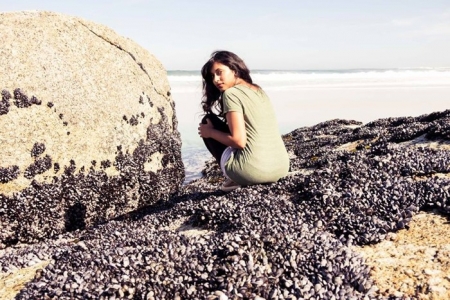On alien marine cities


Saachi Saadchatheeswaran in her happy place. This picture is from Nathan Stasin’s album, My Thesis and Me
In a bigger nutshell, Saachi adds, her marine eco-modelling study is focused on the intertidal rocky shores of Marcus Island, Saldanha Bay. Between 1980 and 2012, the island was invaded by three alien invasive species: the Mediterranean mussel, the bisexual mussel and the Pacific barnacle.
These species came from the Mediterranean Sea, Chile and North America respectively and are currently among the most dominant intertidal species on the west coast of South Africa.
“What makes them interesting is that they are all capable of building ‘cities’ and the structure of the ‘cities’ basically decides which native species can do really well on the shore and which can’t.”
Sadchatheeswaran uses 3D modelling to measure the irregular spaces created by these aliens that can be used as shelter for native species. She uses those measurements to help create predictive temporal–spatial models of the intertidal zone.
“The meat of my thesis is about recreating and testing the ecosystem services provided by this architectural complexity on rocky shores,” she explains.
“For my thesis we’re introducing the term ‘architectural complexity’ to refer to the 3D spaces which we measure, and then we’re also creating a plugin to pull this architectural complexity into the spatial maps for the predictive modelling routine.”
Alien investigators
The “we” Sadchatheeswaran speaks of refers to her co-supervisors: Associate Professor Coleen Moloney, Emeritus Professor George Branch, Dr Tamara Robinson and Dr Lynne Shannon. She is also advised by Dr Marta Coll and Jeroen Steenbeck.
They played a defining role in her decision to pursue a master’s (which she upgraded to a PhD after the first year) in the subject.
“I think my enthusiasm is mostly fostered from how my supervisors treat me and my project,” she says. “From the very beginning, even when I was just an intern sorting samples for what would eventually, and unknowingly, become my master’s and then doctoral project, the project always felt like it belonged to me.
“Also, I had so much freedom and support from my supervisors that I could actually incorporate my biggest passion – 3D modelling – into my thesis somehow. Eventually, 3D modelling became the basis for my whole thesis, and I was able to use it to explore and simplify a really complex topic.”
She had planned from the outset to upgrade her master’s studies to a PhD, but it was still no easy road.
“In January 2014 I gave a proposal for my full PhD to what I think was the entire marine department. I was super nervous, and spoke really fast, but somehow the department still understood me and thankfully approved the project.”
What is biomimicry?
“Okay, so this is a fantastic beast that I deal with outside of my thesis,” says Sadchatheeswaran. “Basically, biomimicry is the design of sustainable technology that can mimic life.”
For instance, the front of a bullet train is shaped like a kingfisher’s beak.
“This beak in particular is excellent for cutting through air and water, and so this specific design is partially why bullet trains are so incredibly fast,” she explains.
She was part of a six-person team that won a biomimicry competition from FESTO (a German-based engineering company) and Biomimicry SA, beating 70 other teams. They built a biomimetic fog harvester.
“Our design was highly effective, but was actually very simple compared to most of the other groups who competed,” she said. “I think we won because we incorporated a full life cycle for the design, and showed how it could engage with the people who used it. For example, we built a water conservation curriculum for schools which might use the fog harvester.”
Spreading the knowledge
Sadchatheeswaran enjoys sharing her love with the next generation of researchers, too.
“I was a demonstrator for Moloney’s biostats course for three years, and I did escape my work quite a few times to help out whenever Ma-Re (UCT’s Marine Research Institute) would host younger students and get them excited about marine science. I was mostly a tour guide, but I got to do a few dissections once or twice.”
At the moment, she is helping to advise a master’s student in Penang, Malaysia. The student is going to recreate the first chapter of Sadchatheeswaran’s thesis, but instead of looking at aliens through time and space, she is looking at the architectural complexity of natural versus artificial rocky shores.
“She’s a super quick learner,” remarks Sadchatheeswaran, adding that it makes it lots of fun teaching her how to use 3D modelling and whatever else she needs.
“I do find myself repeating the same advice my supervisors are always giving me, which I find mostly traumatising, but also mildly hilarious.”
On her post-PhD plans, Sadchatheeswaran reckons she would be happiest working in a multi-disciplinary team. She would especially like to work with architects and engineers.
“When I submit the final copy – and have spent at least two weeks vegetating – I’m going to apply to all the civil design and civil engineering firms in Toronto, Canada. Hopefully someone will realise they need me and hire me. Then I'll get a small condo, a furry and lovable pet and just make models all day.”
Story Yusuf Omar. Photo Nathan Stasin.